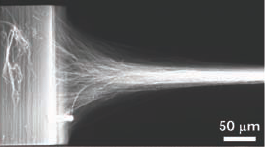Literature on Carbon Nanotube Research: Difference between revisions
(/* [http://www.sciencedirect.com/science?_ob=ArticleURL&_udi=B6TXD-4625DK9-1J&_user=10&_rdoc=1&_fmt=&_orig=search&_sort=d&view=c&_acct=C000050221&_version=1&_urlVersion=0&_userid=10&md5=10f7d5757efbd36ce57d5e0dc74f7990 B. G. Demczyk et al., Materials) |
No edit summary |
||
| Line 37: | Line 37: | ||
[[Image:CNTspinning.png]] | [[Image:CNTspinning.png]] | ||
==[http://www.sciencedirect.com/science?_ob=ArticleURL&_udi=B6TXD-4625DK9-1J&_user=10&_rdoc=1&_fmt=&_orig=search&_sort=d&view=c&_acct=C000050221&_version=1&_urlVersion=0&_userid=10&md5=10f7d5757efbd36ce57d5e0dc74f7990 B. G. Demczyk et al. | ==[http://www.sciencedirect.com/science?_ob=ArticleURL&_udi=B6TXD-4625DK9-1J&_user=10&_rdoc=1&_fmt=&_orig=search&_sort=d&view=c&_acct=C000050221&_version=1&_urlVersion=0&_userid=10&md5=10f7d5757efbd36ce57d5e0dc74f7990 B. G. Demczyk et al., Materials and Engineering, '''A334''', 173-178, 2002] == | ||
The paper by Demczyk et al. (2002) is the basic reference for the | The paper by Demczyk et al. (2002) is the basic reference for the | ||
experimental determination of the tensile strengths of individual | experimental determination of the tensile strengths of individual | ||
Revision as of 16:00, 17 March 2009
| Title: CNT Literature | ||
|
About:
|
Tags:
|
|
Literature Review
I have hijacked this page to write down my views on the literature on Carbon Nanotube (CNT) growths and processing, a procedure that should give us the cable/ribbon we desire for the space elevator. I will try to put as much information as possible here. If anyone has something to add, please do not hesitate!
B. G. Demczyk et al., Materials and Engineering, A334, 173-178, 2002
The paper by Demczyk et al. (2002) is the basic reference for the experimental determination of the tensile strengths of individual Multi-wall nanotube (MWNT) fibers. The experiments are performed with a microfabricated piezo-electric device. On this device CNTs in the length range of tens of microns are mounted. The tensile measurements are obseverd by transmission electron microscopy (TEM) and videotaped. Measurements of the tensile strength (tension vs. strain) were performed as well as Young modulus and bending stiffness. Breaking tension is reached for the SWNT at 150GP and between 3.5% and 5% of strain. During the measurements 'telescoping' extension of the MWNTs is observed, indicating that single-wall nanotubes (SWNT) could be even stronger. However, 150GPa remains the value for the tensile strength that was experimentally observed for carbon nanotubes.
M. Zhang, K. R. Atkinson, and R. H. Baughman, Science, 306, 1358-1361, 2004
In the research article by M. Zhang et al. (2004) the procedure of spinning long yarns from forests of MWNTs is described in detail. The maximum breaking strength achieved is only 0.46 GPa based on the 30micron-long CNTs. The initial CNT forest is grown by chemical vapour deposition (CNT) on a catalytic substrate, as usual. A very intersting formula for the tensile strength of a yarn relative to the tensile strength of the fibers (in our case the MWNTs) is given:
where alpha is the helix angle of the spun yarn, i.e. fiber direction relative to yarn axis. The constant k=sqrt(dQ/mu)/3L is given by the fiber diameter d=1nm, the fiber migration length Q (distance along the yartn over which a fiber shifts from the yarn surface to the deep interior and back again), the mu=0.13 is the friction coefficient of CNTs (the friction coefficent is the ratio of maximum along-fiber force divided by lateral force pressing the fibers together), L=30micron is the fiber length.
In the paper interesting transmission electron microscope (TEM) pictures are shown, which give insight into how the yarn is assembled from the CNT forest. The authors describe other characteristics of the yarn, like how knots can be introduced and how the yarn performs when knitted, apparently in preparation for application in the textile industry.
K. Koziol et al., Science, 318, 1892, 2007.
The paper "High-Performance Carbon Nanotube Fiber" by K. Koziol et al. is a research paper on the production of macroscopic fibers out of an aerogel (low-density, porous, solid material) of SWNT and MWNT that has been formed by carbon vapor deposition. They present an analysis of the mechanical performance figures (tensile strength and stiffness) of their samples. The samples are fibers of 1, 2, and 20mm length and have been extracted from the aerogel with high winding rates (20 metres per minute). Indeed higher winding rates appear to be desirable, but the authors have not been able to achieve higher values as the limit of extraction speed from the aerogel was reached, and higher speeds led to breakage of the aerogel.
They show in their results plot (Figure 3A) that typically the fibers split in two performance classes: low-performance fibers with a few GPa and high-performance fibers with around 6.5 GPa. It should be noted that all tensile strengths are given in the paper as GPa/SG, where SG is the specific gravity, which is the density of the material divided by the density of water. Normally SG was around 1 for most samples discussed in the paper. The two performance classes have been interpreted by the authors as the typical result of the process of producing high-strength fibers: since fibers break at the weakest point, you will find some fibers in the sample, which have no weak point, and some, which have one or more, provided the length of the fibers is in the order of the frequency of occurrence of weak points. This can be seen by the fact that for the 20mm fibers there are no high-performance fibers left, as the likelihood to encounter a weak point on a 20mm long fiber is 20 times higher than encountering one on a 1mm long fiber.
As a conclusion the paper is bad news for the SE, since the difficulty of producing a flawless composite with a length of 100,000km and a tensile strength of better than 3GPa using the proposed method is enormous. This comes back to the ribbon design proposed on the Wiki: using just cm-long fibers and interconnect them with load-bearing structures (perhaps also CNT threads). Now we have shifted the problem from finding a strong enough material to finding a process that produces the required interwoven ribbon. In my opinion the race to come up with a fiber of better than Kevlar is still open.

